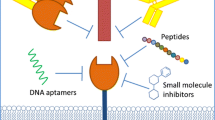Abstract
Malignant tumours secrete factors that enable them to commandeer their own blood supply (angiogenesis), and blocking the action of these factors can inhibit tumour growth. But because tumours may become resistant to treatments that target individual angiogenic factors by switching over to other angiogenic molecules1,2, a cocktail of multiple anti-angiogenic agents should be more effective. Here we show that herceptin3, a monoclonal antibody against the cell-surface receptor HER2 (for human epidermal growth factor receptor-2; ref. 4), induces normalization and regression of the vasculature in an experimental human breast tumour that overexpresses HER2 in mice, and that it works by modulating the effects of different pro- and anti-angiogenic factors. As a single agent that acts against multiple targets, herceptin, or drugs like it, may offer a simple alternative to combination anti-angiogenic treatments.

Similar content being viewed by others
References
Jain, R. K. & Carmeliet, P. F. Sci. Am. 285, 38–45 (2001).
Fidler, I. J. J. Natl Cancer Inst. 93, 1040–1041 (2001).
Slamon, D. J. et al. N. Engl. J. Med. 344, 783–792 (2001).
Yarden, Y. & Sliwkowski, M. X. Nature Rev. Mol. Cell Biol. 2, 127–137 (2001).
Kerbel, R. S., Viloria-Petit, A., Klement, G. & Rak, J. Eur. J. Cancer 36, 1248–1257 (2000).
Allgayer, H. et al. J. Clin. Oncol. 18, 2201–2209 (2000).
Nicolini, G., Miloso, M., Moroni, M. C., Beguinot, L. & Scotto, L. J. Biol. Chem. 271, 30290–30296 (1996).
Thurston, G. et al. Science 286, 2511–2514 (1999).
Bornstein, P. J. Clin. Invest. 107, 929–934 (2001).
Jain, R. K. Nature Med. 7, 987–989 (2001).
Fukumura, D. et al. Cell 94, 715–725 (1998).
Jain, R. K., Munn, L. L. & Fukumura, D. Nature Rev. Cancer (in the press).
Author information
Authors and Affiliations
Corresponding author
Ethics declarations
Competing interests
The study reported in this paper was in part supported by Genentech.
Additional information
brief communications is intended to provide a forum for both brief, topical reports of general scientific interest and technical discussion of recently published material of particular interest to non-specialist readers. Priority will be given to contributions that have fewer than 500 words, 10 references and only one figure. Detailed guidelines are available on Nature's website (http://www.nature.com) or on request from nature@nature.com
Rights and permissions
About this article
Cite this article
Izumi, Y., Xu, L., di Tomaso, E. et al. Herceptin acts as an anti-angiogenic cocktail. Nature 416, 279–280 (2002). https://doi.org/10.1038/416279b
Issue Date:
DOI: https://doi.org/10.1038/416279b
- Springer Nature Limited
This article is cited by
-
Plasma THBS1 as a predictive biomarker for poor prognosis and brain metastasis in patients with HER2-enriched breast cancer
International Journal of Clinical Oncology (2024)
-
RUNX3 regulates the susceptibility against EGFR-targeted non-small cell lung cancer therapy using 47Sc-conjugated cetuximab
BMC Cancer (2023)
-
Long non-coding RNAs as the critical regulators of PI3K/AKT, TGF-β, and MAPK signaling pathways during breast tumor progression
Journal of Translational Medicine (2023)
-
Inhibition of PFKFB3 in HER2-positive gastric cancer improves sensitivity to trastuzumab by inducing tumour vessel normalisation
British Journal of Cancer (2022)
-
Obesity and cancer—extracellular matrix, angiogenesis, and adrenergic signaling as unusual suspects linking the two diseases
Cancer and Metastasis Reviews (2022)





